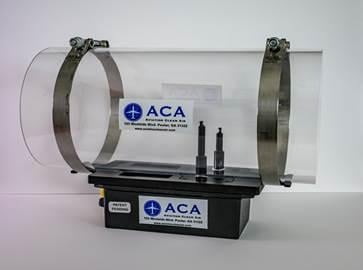
Figuring out how to make passengers comfortable boarding aircraft again, without having to block off middle seats indefinitely, is a problem the industry needs to solve sooner rather than later.
One potential solution, or part of the solution, is available and received an FAA supplemental type certificate (STC) on May 26 for installation on most Part 25 transport category aircraft. It releases positive and negative ions into an aircraft’s environmental control system (ECS). The ions surround harmful pathogens, breaking the hydrogen bonds and causing the pathogens in the air and on surfaces to die. The ions also remove volatile organic compounds (VOCs), odors and allergens introduced into the cabin by passengers or the environment.
The system has been proven in lab tests performed by EMSL to reduce the threat of E.coli, viruses, tuberculosis, season flu, common colds and other viruses and bacteria.
Specifically, within 30 minutes, the Aviation Ion Generator system from Aviation Clean Air (ACA) disinfected 86.87% of C.difficile on a solid surfaces, 96.24% of MRSA from the air after 30 minutes, and 99.71% of Legionella pneumophil, says Howard Hackney, managing member of ACA. Given the commonality between coronaviruses, ACA expects that the technology will be as effective against the COVID-19 virus as SARS.
The air ionization system is available as part of a package—including the kit and product support--from Aloft AeroArchitects, which received the FAA approved model list STC on May 26.
When the pandemic started to proliferate, Aloft AeroArchitects started looking for solutions to disinfect its clients’ aircraft, many of which are Boeing Business Jets, and wanted to make sure none of the exotic or delicate materials would be damaged in the process. In looking for solutions, Aloft knew it had installed the ACA ion generator system in a VIP aircraft a few years ago in a one-off STC, so it was able to isolate the data set from that installation and create an approved model list STC that applies to most Part 25 aircraft—narrowbody or widebody, says Matt Hill, Aloft AeroArchitects’ VP sales and marketing.
“The idea of this product is to take away roadblocks and return confidence to the flying public,” says Hill. While Aloft caters to VIP customers, it used its Organization Designation Authorization to create this solution and get it certified as quickly as possible because “we want to do our part to help the industry,” he says.
In a narrowbody, “air velocity in cabins can turn over about 20 times per hour, so every 2-3 minutes there’s an air exchange,” says Hill. That air also passes through HEPA filters, so the air in cabins is already quite clean, despite the common public misperception.
However, when the ionizer units, which are basically probes, are installed in the ECS, the air passes through the probes that impart ions distributed to the cabin. The ions then attack pathogens on seats, tray tables and any other surface, as well as eliminate cabin odors continuously.
The product can be installed during a few overnight checks or during a B or C check. A narrowbody will require an average of four units, each of which weighs 1.4 lbs., and a widebody could take six to eight units. The installation includes configuration flexibility to account for variations in the electric power tie-in and indicator panel locations.
The system does not require scheduled maintenance and does not include moving parts. Aloft recommends checking the unit during a C check, a process that should take less than 10 minutes, says Hill.
Hillwood Airways in Dallas is the Part 121 launch customer, and Hill expects the prototype to take about 100 man-hours of installation time, but decrease as it optimizes the process.
Hillwood is purchasing the ACA ionization system for each of its four Boeing 737-700s. Its maintenance staff will install the system, overseen by Aloft maintenance personnel, at its Fort Worth Alliance Airport base, says Ched Bart, president and CEO of Hillwood Airways.
“Since we recently installed the ACA System in two Gulfstream aircraft belonging to Hillwood’s parent company, we made a quick call to ACA to ask about possible airliner applications for their ionization product,” he says. “Hillwood’s comprehensive research did not identify another cost-effective system capable of ionization technology, hence our choice of the ACA System,” he adds.
Aloft, formerly PATS Aircraft Systems and owned by NexPhase Capital, didn’t disclose the unit and installation cost but said it’s in the “hundreds of thousands of dollars per plane,” which airlines could recoup by not having to block seats. However, it recognizes airlines are guarding their cash. Given that, Hill says, “We’re working with our partners to see how we can structure this for fast adoptions recognizing that the cash flow in the industry has changed dramatically last months.”
The first ACA system installation was on a Falcon 2000 in May 2014, followed by ones on a Gulfstream G550 and then a Boeing Business Jet, says Hackney. It is installed on more than 110 aircraft so far, he says.
“From an integrator standpoint, we looked at a lot of options and this one looked the best for fast, easy adoption,” says Hill. He predicts that airlines might start installing the kits on aircraft that fly internationally to help stop viruses proliferating from continent to continent.






Comments